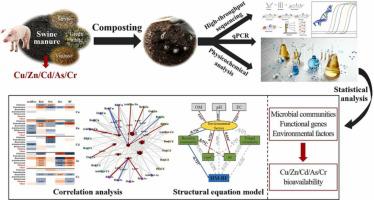Journal of Hazardous Materials ( IF 13.6 ) Pub Date : 2021-12-17 , DOI: 10.1016/j.jhazmat.2021.128103 Hao-Nan Guo 1 , Hong-Tao Liu 2 , Shubiao Wu 3

|
Excessive heavy metals (HMs) in livestock manure due to additives over-use limits its recycling through composting. However, few studies have investigated the interactive influence of microbial communities, functional genes, and environmental factors in HM immobilization during composting. Therefore, treatments with different C/N ratios (15:1, 20:1, 25:1) and bulking agents (maize straw, green waste, vinasse) were conducted to explore the HMs immobilization pathways using structural equation model (SEM). Results confirmed the promoting effect of C/N ratio of 20:1 and vinasse on microbial diversity, thus leading to greater HMs immobilization rate. Meanwhile, the dominant microbial phyla of Cu/Zn, Cd, As, and Cr were identified as Proteobacteria, Firmicutes, Chytridiomycota, and Bacteroidota, respectively. Moreover, the significant correlation between functional genes (copC, mt, cbh1, aoxB, yieF) and HMs illustrated potential immobilization effects of metal-binding proteins on Cu and Zn, humus complexation on Zn, and oxidase/reductase on As/Cr. Finally, SEM indicated that the redistribution of Cu, Zn, As, and Cr fractions was interactively influenced by environmental factors (organic matter, pH, electrical conductivity, and total phosphorus), microbial communities, and functional genes, while Cd was directly regulated by organic matter and total phosphorus. These results may provide a deeper understanding of HM immobilization pathways during swine manure composting.
中文翻译:

堆肥中重金属的固定化途径:不同C/N比和填充剂下微生物群落与功能基因的相互作用
由于添加剂过度使用,牲畜粪便中过量的重金属 (HMs) 限制了其通过堆肥回收。然而,很少有研究调查堆肥过程中微生物群落、功能基因和环境因素在 HM 固定中的交互影响。因此,采用结构方程模型(SEM)进行了不同C/N比(15:1、20:1、25:1)和填充剂(玉米秸秆、绿色废料、酒糟)的处理,以探索HMs的固定途径。结果证实了20:1的C/N比和酒糟对微生物多样性的促进作用,从而导致更高的HMs固定率。同时,Cu/Zn、Cd、As和Cr的优势微生物门被确定为变形菌门、厚壁菌门、壶菌门和拟杆菌门,分别。此外,功能基因(copC、mt、cbh1、aoxB、yieF) 和 HMs 说明了金属结合蛋白对 Cu 和 Zn、腐殖质络合对 Zn 以及氧化酶/还原酶对 As/Cr 的潜在固定作用。最后,SEM 表明,Cu、Zn、As 和 Cr 组分的重新分布受环境因素(有机质、pH、电导率和总磷)、微生物群落和功能基因的交互影响,而 Cd 直接受有机质和总磷。这些结果可以更深入地了解猪粪堆肥过程中 HM 的固定途径。



























 京公网安备 11010802027423号
京公网安备 11010802027423号